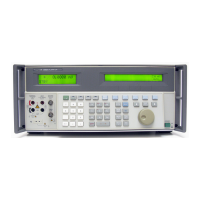Front Panel Operation
Waveform Types
4
4-41
4-35. Sinewave
When the wave selection is sine, a sinewave current or voltage signal is present on the
calibrator outputs (Figure 4-11). The variables for the sinewave are amplitude,
frequency, and dc offset voltage.
Peak
Period
RMS (70.7% of Peak)
Figure 4-11. Sinewave
4-36. Trianglewave
When the wave selection is tri, the trianglewave is present on the calibrator outputs
(Figure 4-12). The variables for the trianglewave are amplitude, frequency, and dc offset
voltage. Whenever a trianglewave is selected, the Output Display indicates amplitudes in
peak-to-peak units.
Peak to Peak
Figure 4-12. Trianglewave
4-37. Squarewave
When the wave selection is square, a squarewave current or voltage signal is present on
the calibrator outputs (Figure 4-13). The variables for the squarewave are duty cycle,
amplitude, frequency, and dc offset voltage. Whenever a squarewave is selected, the
Output Display indicates amplitude in peak-to-peak units. If the calibrator is set for a
single voltage or current output, the duty cycle of the signal can be set through the
keypad. To enter a new duty cycle, press the DUTY CYCLE softkey and up to five
numeric keys followed by E. The negative-going edge of the squarewave will
move based on the duty cycle setting.

